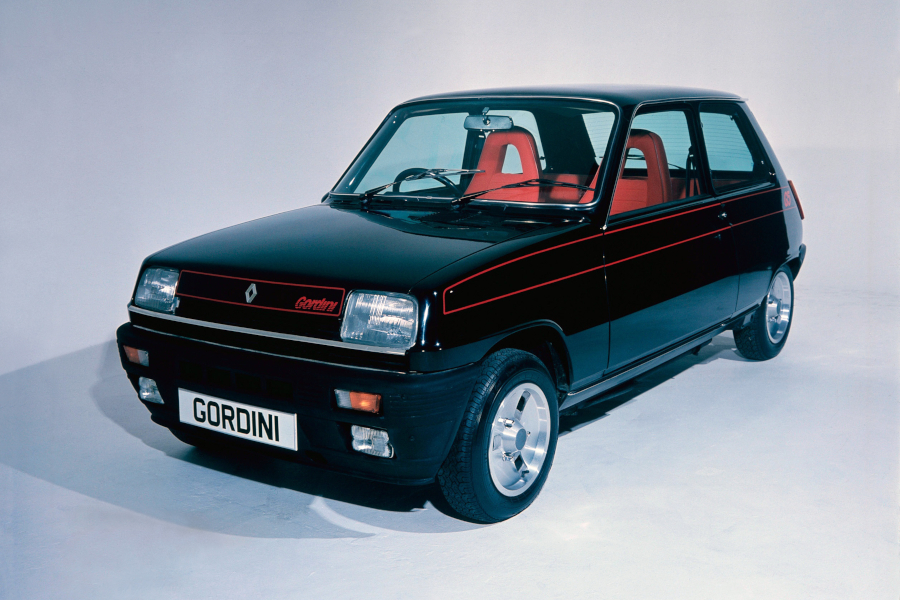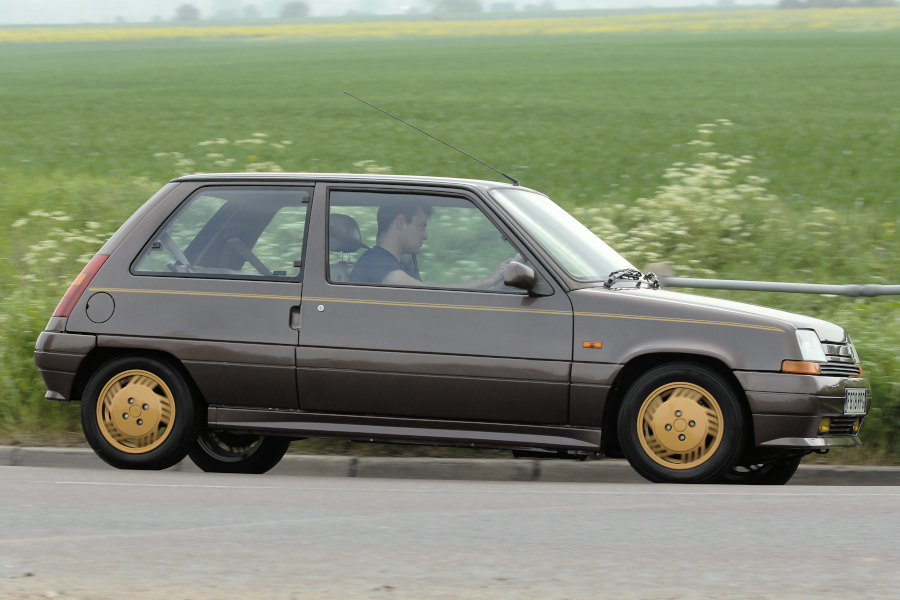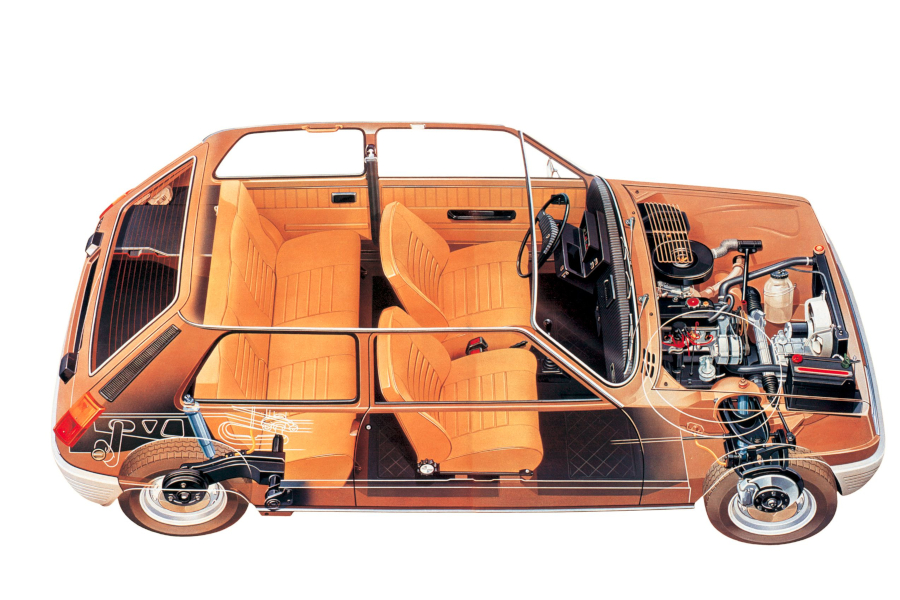One of Europe’s longest-lived superminis and a bestseller for many years, the Renault 5 range offers everything from runabout to hot hatch
Words: Paul Guinnes
Launching in 1972 and surviving for 12 years, the first-generation Renault 5 proved to be a major success, with almost 5.5 million sold. Unlike the Fiat 127 and most later rivals, the Renault employed a longitudinally-mounted engine, but in every other respect was a genuine supermini, with neat looks, an entertaining driving style, hatchback versatility and a wide range of derivatives to choose from.
Although the French-spec 782cc version was never imported, UK buyers would be offered 5s with 845, 956, 1108, 1289 and 1397cc engines over the years, as well as a wide range of trim levels and – in later life – a five-door version. It even helped to invent the hot hatch segment thanks to the launch of the Gordini (known as the Alpine in France), featuring a tuned (93bhp) version of Renault’s 1.4-litre motor; and there was more excitement in late 1981 when the Gordini Turbo was launched, its Garrett turbocharger boosting power to 110bhp.

The next-generation Renault 5 – known in its homeland as the Supercinq – arrived in ’84, with its Marcello Gandini-penned styling deliberately paying homage to the Mk1. The three-door arrived first, followed by the five-door in May 1985. The platform was based on that of the larger Renault 9/11, making the new 5 wider and longer than the car it replaced, with more space inside.
Four trim levels were initially available (TC, TL, GTL and Automatic), with engines ranging from 956cc to 1397cc. Diesel versions followed in November 1985, while in ’87 came a 1721cc petrol engine for the new GTX, GTE and Monaco. For hot hatch fans, meanwhile, there was the 1985-on GT Turbo, its 1.4-litre (115bhp) engine boosted via a Garrett T2 turbocharger; the Phase 2 version of ’87 brought 120bhp plus a new grille, wheels and colour-coded body kit.
The GT Turbo died in 1991 but the regular Supercinq lived on in basic Prima spec until ’96, despite the arrival of its successor, the Clio, as early as 1990.

Bodywork
You won’t be surprised to learn that the Renault 5’s biggest enemy is rust – something that can apply as much to a late-model Mk2 as it can to an original Mk1. Later cars were better protected against corrosion than the earliest models, but in reality any Renault 5 can rot alarmingly when neglected.
On the Mk1 in particular, both inner and outer wings are vulnerable, as are the bottoms of the doors, the tailgate and the front edge of the bonnet. You should also carefully examine the rear wheelarches, the sills and both front and rear screen surrounds for signs of rot, bubbling and previous repairs. We still come across Renault 5s that have had poor-quality work carried out in the past, so make sure you carefully inspect the entire underside for signs of rot and bad welding, especially around the rear suspension mounts. Bubbling under a vinyl roof or around the side plastic protectors is also a sign of hidden corrosion that’s waiting to be exposed.
The same areas need inspecting on any Supercinq, while on a GT Turbo in particular you should be on the look-out for signs of accident repairs and previous damage. The most abused examples have long since disappeared, killed off by boy racers in the ’90s, but some dodgy ones still survive. Even on a tidy looking example, pay particular attention to any body sections hidden by plastic trim that can easily hide rot problems.
Genuine Renault body panels aren’t easy to find, although Ex-Pressed Steel Panels (www.steelpanels.co.uk) does produce new front wings for both the Mk1 and Mk2, priced at around £172 and £197 each respectively. European suppliers tend to stock a wider range of reproduction panels, including Germany’s Der Franzose (www.franzose.de) and Spain’s Repuestos Classic (www.repuestosclassic.es), which between them can supply front wings, floorpans, rear wheelarches, sills and more. France will also be a useful source of Renault 5 panels, so keep your search international if you need any particular parts.
Engine and transmission
The first-gen Renault 5 boasted a spread of engines that (in UK spec) went from the 845cc ‘Ventoux’ through to the 1.4-litre ‘Sierra’ unit – and the good news is that they’re all tough and reliable powerplants when maintained properly. Their use of alloy cylinder heads makes it essential to have the correct ratio of good-quality antifreeze in the coolant; it’s not unknown for corrosion and leaks to lead to overheating issues, which can mean head gasket failure. You should also listen out for rattling valve gear, while any excessive smoke on start-up might suggest perished valve stem oil seals.
You should carry out the same checks with the Mk2 as well, although any turbocharged Renault 5 brings its own complications. Many examples will have been previously uprated or modified, so make sure any such work has been done well. The GT Turbo’s engine bay is tightly packed full of tubing and vacuum hoses, with poor heat suppression on early examples; Phase 2 models have an ‘anti-percolation’ fan that helps to keep the Solex carb cool, though many owners have fitted extra heat shielding and stronger electric fuel pumps to keep fuel temperatures down.
Early Renault 5s came with four-speed manual transmission as standard, with a five-speed manual and three-speed automatic being added later. None of the gearboxes are known for being troublesome, but it still pays to listen out for whining bearings and to check for worn synchromesh on first and second. If you’re buying a very early car with a dash-mounted gearstick, difficulty in engaging gears will almost certainly be down to a worn linkage – and that’s a fairly easy fix. Don’t forget to check the state of the clutch, as replacement of this on a Mk1 involves removing both the gearbox and the steering rack.

Suspension, steering and brakes
Non-sporting Renault 5s are simple in spec, with nothing likely to scare away the DIY classic fan.
Aside from the usual wear in bushes and joints that comes with age and mileage, the rack and pinion steering should be trouble-free, and the same goes for the suspension. All models feature a coil-sprung independent set-up with telescopic dampers up front, while at the rear there’s a torsion bar arrangement. You should check for signs of wear, but bear in mind that a standard model has typically French suspension settings and can therefore feel ‘soft’ when cornering.
Upper and lower front ball joints often wear, and you’ll need to check for rot in the torsion bar mounting points as well as the rear trailing arm mounts. Classic Renault specialists around Europe can help with suspension parts, with Der Franzose selling new shock absorbers from less than €38 (£33) each.
Early Renault 5s came with all-drum brakes, though later models had front discs and the Gordini Turbo and subsequent GT Turbo had discs all round. Carry out the usual checks for brake wear, looking for leaking cylinders, scored discs, worn pads/shoes and general neglect. The brakes of the sportiest Renault 5s will have led a hard life, so make sure they’ve been well-maintained.
Interior, trim and electrics
The quality of its interior trim wasn’t a Renault 5 strong point, so be extra careful when buying – particularly as original-spec new trim is all but impossible to find. Early basic cars with vinyl upholstery were fairly robust, but the cloth seats of ‘posher’ versions will show signs of wear on all but the lowest-mileage cars.
The Supercinq’s upholstery tends to be slightly more hardwearing but is still prone to wear. On a GT Turbo in particular, the outer side bolsters of the front seats will wear through, while the hard plastic dashboard fitted to all Mk2 models is prone to cracks and damage; even by standards of the 1980s, it was a brittle affair and needs careful inspection now.
The later the car, the better equipped it will tend to be (except in the case of the run-out Prima model), so make sure the electrics are working as they should, as problems are commonplace. It’s not unusual to find non-functioning electric windows, erratic lighting and dodgy dials; it’s important to be thorough when checking.
Renault 5: our verdict
The Renault 5 was an early pioneer of the supermini sector, a model that went on to enjoy a long career over two generations and via a multitude of different derivatives. It was a popular buy here in the UK when new, and still holds plenty of appeal today. Whether you’re looking for a practical and economical small classic or a high-performance hot hatch, there’s likely to be a Renault 5 that fits the bill.
It’s not without its issues, of course, and it won’t necessarily be the easiest classic supermini to track down – particularly if your heart is set on an early Mk1. But with its combination of Gallic charm, an easy driving style, low running costs and decent value for money, any well-preserved survivor makes a tempting proposition.
With such a wide spread of models available, there’s a Renault 5 to suit most budgets. Among the non-sporting versions, the Supercinq is the most affordable, with project cars available for less than £1000; a solid example that’s MoT’d and ready for regular use might cost you £2000-£2500, while a superb car should top out at £4000 or so. Mk1s start at a higher level, with decent examples (solid but not immaculate) available for £3000-£3500, while around £5000-£5500 should buy you an excellent survivor that’s ready to show.
Sporting models are in another league, though, with a low-mileage GT Turbo in exceptional condition likely to achieve £15,000-plus, although a good example with a lengthy MoT can often be found for £7000-£9000. Mk1 Gordinis achieve strong money too, with a sale price of up to £10,000 not unusual for a decent example, though a Gordini Turbo in very good order can make £12,000-plus.

Renault 5 timeline
1972
Renault 5 launches as 845cc/956cc three-door, plus 782cc version for French buyers
1976
5 GTL features 1289cc engine and higher gearing for extra economy; ‘hot’ 5 Alpine launches in France
1978
Automatic version debuts; 93bhp Gordini (rebadged Alpine) launches in the UK
1979
Five-door Renault 5 makes its debut
1981
Gordini replaced by 110bhp ‘blown’ Gordini Turbo; GTL and Automatic get 1.4-litre engine
1984
All-new Renault 5 – known in France as Supercinq – launches, with 956 to 1397cc engines
1985
UK sales of new Renault 5 begin in February; 115bhp GT Turbo hot hatch is announced
1987
956cc version dropped, 1237cc/1721cc engines added to the range; Phase2 GT Turbo brings 120bhp and new body kit
1990
Launch of new Clio sees drastic reduction in Renault 5 range
1996
Renault 5 (available solely in entry-level Prima spec in recent years) finally discontinued



















